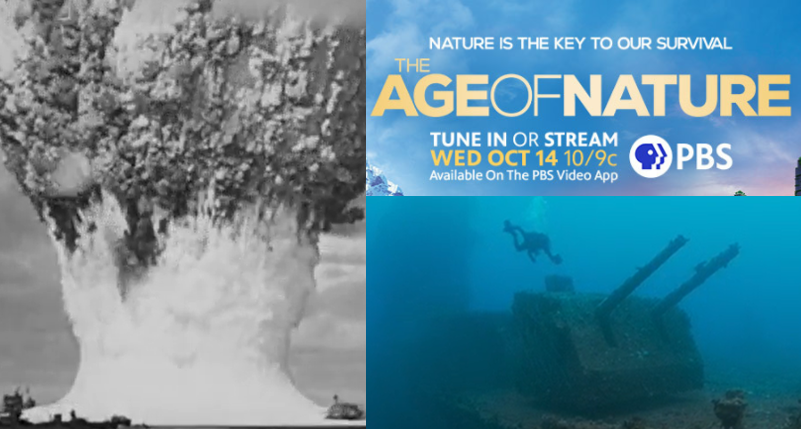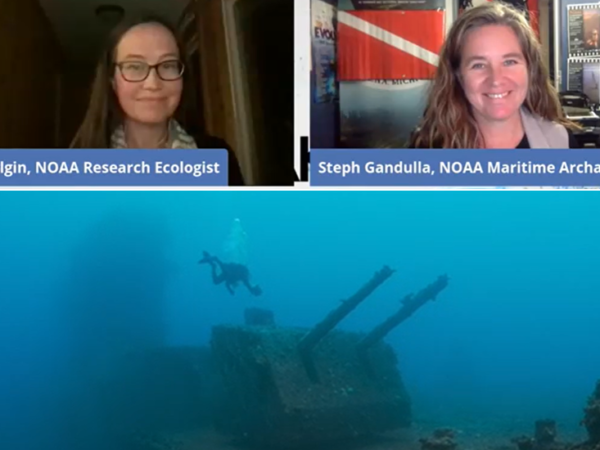
Join Great Lakes Now‘s “Shipwrecks and ecosystems in the Great Lakes” watch party on Monday, Oct. 12, at 7 p.m. EST. A maritime archaeologist with NOAA’s Thunder Bay National Marine Sanctuary and a benthic ecologist with NOAA’s Great Lakes Environmental Research Laboratory will be participating in a Q&A. Click here for more information.
The nuclear weapons testing from 1946-1958 at Bikini Atoll in the Pacific Ocean’s Marshall Islands decimated the marine life and environment there. But when a team of researchers arrived decades later, they found some 80% of the native species had returned to thrive among the sunken ships and other debris.
“The wrecks really kind of capture that: nature reclaiming what we leave behind, just moving on, doing what it does,” said Pete Lown, one of the producers of the three-part PBS documentary, “The Age of Nature,” which opens with scenes from Bikini Atoll.
Lown spoke with Great Lakes Now Host Ward Detwiler about the powerful symbolism of marine life returning to the wrecks in advance of “The Age of Nature” broadcasts on Wednesdays Oct. 14, 21 and 28, 2020.
Watch his comments about shipwrecks and ecosystems here:
Great Lakes shipwrecks, which number in the thousands, also offer new habitat for aquatic life. Read Great Lakes Now’s Kathy Johnson’s article “Shipwreck Life: How fish and other aquatic species utilize Great Lakes shipwrecks.”
Below is an excerpt about shipwrecks from GLN Host Ward Detwiler’s conversation with Pete Lown. A longer conversation with two producers for “The Age of Nature” is HERE.
Great Lakes Now Host Ward Detwiler: Your documentary series, “The Age of Nature,” which is airing on PBS stations in October, starts out with scenes from Bikini Atoll, including the sunken ships there. Describe those sites and the ecosystems that have developed. We have a lot of shipwrecks in the Great Lakes, although they’re in freshwater.
The Age of Nature’s Pete Lown: There was a lot of symbolism in that imagery of these canons pointing up toward the surface with shoals and fish swimming around them like they were rocks. It felt like it was a shadow of the past that nature reclaims. I think that’s quite poignant for people to sort of think that when we sort of leave nature alone, it will reclaim and it will recolonize, and I think that was a major revelation for the people who went back there. I really don’t think they expected to see what they saw. They were really lucky that there was a baseline study of all the coral that was there prior to the blasts so they had a full inventory to look for. They were blown away – they said 80% of the species had returned and they think it could have been more but the rest was too deep for them to reach. You don’t get a much more of a kind of powerful symbol of nature’s recovery. I think that the wrecks really kind of capture that: nature reclaiming what we leave behind, just moving on, doing what it does.
For more of the connections between Great Lakes Now and issues presented in “The Age of Nature,” visit GreatLakesNow.org/Age of Nature or check out our PLAYLIST on our YouTube channel.
For more Great Lakes Now work on shipwrecks:
Shipwreck fragment emerges along Lake Michigan beach
“Dream Big”: Diving the five lakes in 24 hours, from the perspective of one of the divers
Explore the Eastland tragedy with a Storymap
Eastland Documentary: Filmmakers talk behind-the-scenes journey and stories
Watch Great Lakes Now’s second episode, “Ships and Shipwrecks,” HERE.
Watch Great Lakes Now’s segment “Chicago’s Eastland Disaster” HERE.




